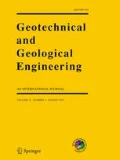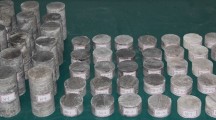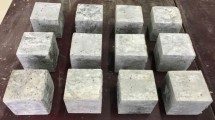Abstract
Based on the theory of energy dissipation, the energy dissipation model of gypsum rock was established, and we analyzed the energy dissipation law of four stages (compaction stage, elastic stage, plastic stage, and failure stage) of gypsum rock failure process with different soaking time. The results show that: the energy of the system (total strain energy, releasable elastic strain energy and dissipative strain energy) changes dynamically. The total strain energy and releasable elastic strain energy decrease with the increase of soaking time. The growth rate is also negatively related to soaking time, while the dissipative strain energy is positively related to soaking time. Then, based on the geological characteristics and test data of gypsum mine in Northern Jiangsu Province, FLAC3D software was used to simulate the stability of goaf under natural and saturated conditions respectively. The simulation results show that the plastic area of goaf was not obvious and the stability was good under natural conditions. In the state of water saturation, most of the area was completely penetrated by the plastic area, the pillar was seriously unstable, which endangers the safety of the goaf.










Similar content being viewed by others
References
Chang C, Zhou DP, Guo ZJ (1998) Effect of water on rock yield strength. J Rock Mech Eng 17(4):407–411
Colback PS, Wild BL (1965) The influence of moisture content on the compressive strength of rock[M]//[S.l.]: National Mechanical Engineering Research Institute, pp 65–83
Dyke CG, Dobereiner L (1991) Evaluating the strength and deformability of sandstones. Quarter J Eng Geol Hydrogeol 24(1):123–134
Feng, G, Kang Y, Wang XC, Hu YQ, Li XH (2020) Investigation on the failure characteristics and fracture classification of shale under brazilian test conditions. Rock Mech Rock Eng. https://doi.org/10.1007/s00603-020-02110-6
Hawkins AB, Mcconnell BJ (1992) Sensitivity of sandstone strength and deformability to changes in moisture content. Q J Eng Geol Hydrogeol 5(2):115–130
Hu Y, Duan KL, Zhang W et al (1990) Study on the influence of pore water pressure on the deformation characteristics of coal. J Shanxi Inst Min 8(4):419–425
Huang H, Babadagli T, Chen X, Li HZ, Zhang YM (2020) Performance comparison of novel chemical agents for mitigating water-blocking problem in tight gas sandstones. SPE Reserv Eval Eng. https://doi.org/10.2118/199282-PA
Jing JJ, Zhu B, Shen YG (2020) Monitoring and early warning analysis of mined-out ground subsidence of Pizhou gypsum mine in Jiangsu Province. Geol Hazards Environ Protect 4:1006–4362
Kang HP (1994) Water damage to rock. Hydrogeology Eng Geol 21(3):39–41
Louis C (1974) Rock hydraulics rock mechanics. Verlay Wien, New York, pp 299–387
Priest, Selvakumar (1982) The failure characteristics of selected british rocks. Transport Research Laboratory, 1982
Ren DZ, Zhou DS, Liu DK, Dong FJ, Ma SW, Huang H (2019) Formation mechanism of the Upper Triassic Yanchang Formation tight sandstone reservoir in Ordos Basin—Take Chang 6 reservoir in Jiyuan oil field as an example. J Pet Sci Eng 178:497–505
Su CD, Zhang ZH (2018) Analysis of plastic deformation and energy characteristics of marble under triaxial compression. J Rock Mech Eng 2:273–280
Tian P (2020) Mechanical analysis of gypsum ore pillar instability and roof failure process. Mod Min 8:1674–6082
Vasarhelyi B (2005) Statistical analysis of the influence of water content on the strength of the Miocene limestone. Rock Mech Rock Eng 38:69–76
Vasarhelyi B, Van P (2006) Influence of water content on the strength of rock. Eng Geol 84:70–74
Wang H, Dyskin A, Pasternak E et al (2020) Experimental and numerical study into 3D crack growth from a spherical pore in biaxial compression. Rock Mech Rock Eng 53:77–102
Wu JN (1981) Rock softening and reservoir earthquake. South China Earthq 3:84–95
Wu JN, Li JK, Yan YD et al (1985) Triaxial experimental study on hydraulic fracturing of rocks in laboratory. South China Earthq 5(3):22–30
Xie HP, Ju Y, Li LY (2005) Criteria for strength and structural failure of rocks based on energy dissipation and energy release principles. Chin J Rock Mech Eng 17:3003–3010
Xie HP, Li LY, Peng RD (2009) Energy analysis and criteria for structural failure of rocks. J Rock Mech Geotech Eng 1(1):11–20
Xu J, Zhang Y, Yang HW et al (2011) Energy evolution of sandstone deformation and damage under cyclic pore water pressure. J Rock Mech Eng 1:141–148
Xu XD, Zhou YJ, Pang S (2018) Analysis of catastrophic instability of plastic supporting system in old goaf of gypsum mine. J Rock Mech Eng 11:1000–6915
Yilmaz I (2010) Influence of water content on the strength and deformability of gypsum. Int J Rock Mech Min Sci 47:342–347
Zhang ZZ, Gao F (2012) Study on nonlinear characteristics of rock energy evolution under uniaxial compression. J Rock Mech Eng 6:1198–1207
Zhang ZZ, Gao F (2015a) Experimental investigation on the energy evolution of dry and water-saturated red sandstones. Int J Min Sci Technol 25(3):383–388
Zhang ZZ, Gao F (2015b) Experimental investigations on energy evolution characteristics of coal, sandstone and granite during loading process. J China Univ Min Technol 44(3):416–422
Acknowledgements
This work was supported by the Research and development project of Guizhou University of Engineering Science (Grant No: G2018016), Technology top talent support project of Guizhou Provincial Education Department ([2017]098), and Technology platform and talent team plan Project ([2018]5622).
Author information
Authors and Affiliations
Corresponding author
Ethics declarations
Conflict of interest
No conflict of interest exists in the submission of this manuscript, and the manuscript is approved by all authors for publication.
Additional information
Publisher's Note
Springer Nature remains neutral with regard to jurisdictional claims in published maps and institutional affiliations.
Rights and permissions
About this article
Cite this article
Xu, X., Cui, X., Liu, X. et al. Damage Analysis of Soaking Gypsum and Safety Evaluation of Goaf: Based on Energy Dissipation Theory. Geotech Geol Eng 38, 6177–6188 (2020). https://doi.org/10.1007/s10706-020-01426-y
Received:
Accepted:
Published:
Issue Date:
DOI: https://doi.org/10.1007/s10706-020-01426-y




